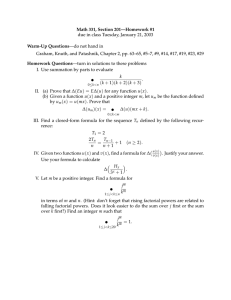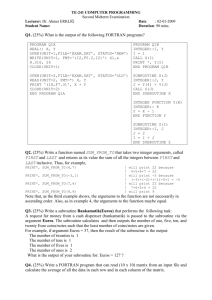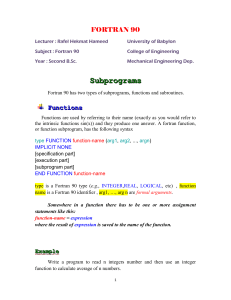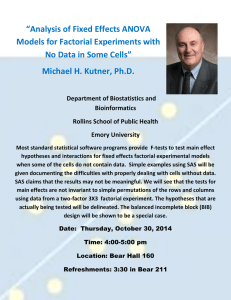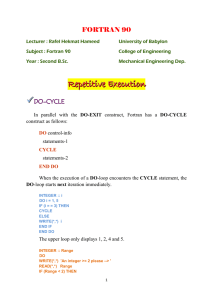FORTRAN 90
advertisement
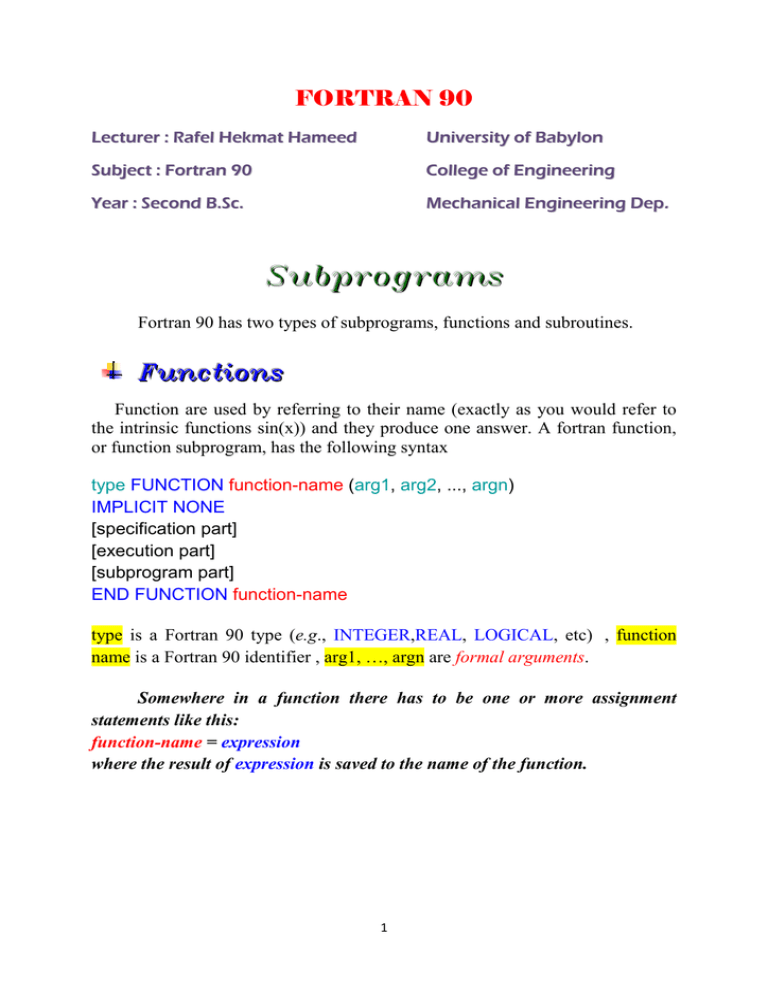
FORTRAN 90 Lecturer : Rafel Hekmat Hameed University of Babylon Subject : Fortran 90 College of Engineering Year : Second B.Sc. Mechanical Engineering Dep. Subprograms Fortran 90 has two types of subprograms, functions and subroutines. F Fu un nc cttiio on nss Function are used by referring to their name (exactly as you would refer to the intrinsic functions sin(x)) and they produce one answer. A fortran function, or function subprogram, has the following syntax type FUNCTION function-name (arg1, arg2, ..., argn) IMPLICIT NONE [specification part] [execution part] [subprogram part] END FUNCTION function-name type is a Fortran 90 type (e.g., INTEGER,REAL, LOGICAL, etc) , function name is a Fortran 90 identifier , arg1, …, argn are formal arguments. Somewhere in a function there has to be one or more assignment statements like this: function-name = expression where the result of expression is saved to the name of the function. ϭ E Ex xa am mp pllee Write a program to read n integers number and then use an integer function to calculate average of n numbers. PROGRAM NUMBERS IMPLICIT NONE INTEGER::N,X,SUM READ(*,*) N DO I=1,N READ(*,*) X SUM=SUM+X ENDDO WRITE(*,50) AVERAGE(SUM,N 50 FORMAT(2X,'AVERAGE=',1X,i5) END INTEGER FUNCTION AVERAGE(SUM,N IMPLICIT NONE INTEGER::N,SUM AVERAGE=SUM/N END FUNCTION AVERAGE E Ex xa am mp pllee Write a program to read n integers number and then use an integer function to calculate the factorial of n. program fact implicit none integer:: factorial,n read*, n write(*,7) factorial(n Ϯ 7format (2x,i5 end function factorial(n implicit none integer::fa,j,n,factorial fa=1 do j=1,n fa=fa*j enddo factorial=fa return end function factorial S Su ub br ro ou uttiin ne ess Subroutines are more general form of subprogram. They can perform complicated tasks that return one or more answer. The syntax of a Fortran subroutine is: SUBROUTINE subroutine-name (arg1, arg2, ..., argn) IMPLICIT NONE [specification part] [execution part] [subprogram part] END SUBROUTINE subroutine-name Unlike functions, which can be used in expressions, subroutines can only be called with the CALL statement. That means, the call to a subroutine must be on its program line rather than somewhere in an expression. The following is the syntax rules of the CALL statement: CALL subroutine-name (arg1, arg2, ..., argn) ϯ E Ex xa am mp pllee Write a program to calculate cosine of angle with error less than 10-9. Use subroutine program to calculate the factorial of the series. Cos(x)=1-x2/2!+x4/4!-x6/6!+…… program cosine implicit none real,parameter::pi=3.14159,error=1e-9 integer::i=1,fact real(kind=8)::sum=1.0,x,term read(*,*)x x=x*pi/180 do call factorial(i,fact term=(-1)**(i)*(x**(2*i))/(fact sum=sum+term if (abs(term)<error)exit i=i+1 enddo write(*,70) sum 70 format(2x,'cos(x)=',e15.1 end subroutine factorial(i,fact) integer::i,fact fact=1 do j=1,2*i fact=fact*j enddo end ϰ E Ex xa am mp pllee A class contains a number of student write a program with subroutine to print the maximum degree and the name of student who take this degree. Use subroutine to enter the student's names and degrees. program student implicit none character (len=20)::name,name1 integer::degree,n,degree1 read(*,*)n call best(n,name,degree,name1,degree1) write(*,30) name1,degree1 30format( 2x,'name of student',2x,a,2x,'degree=',i3) end subroutine best(n,name,degree,name1,degree1) implicit none character(len=20)::name1,name integer::degree1,i,degree,n do i=1,n read(*,*) name,degree if(degree>degree1)then degree1=degree name1=name endif enddo end ϱ
